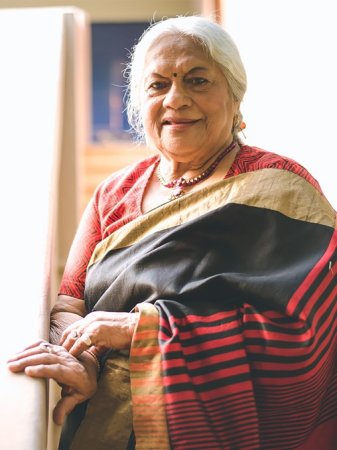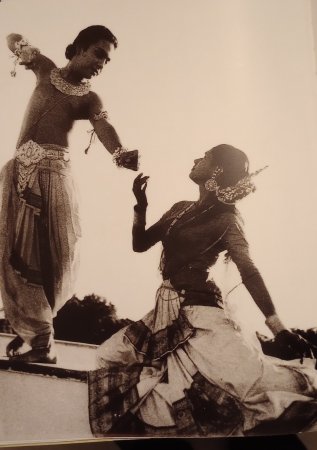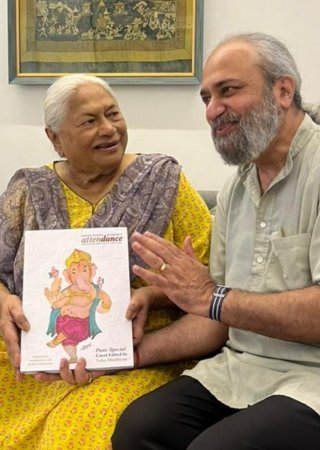 |
  |
 |
  |
Kumudini Lakhia (1930-2025) - Ashish Mohan Khokar e-mail: khokar1960@gmail.com April 12, 2025  A leading Kathak artiste-guru, who sanitized the form and distinguished herself as a contemporary choreographer, bows out on April 12, 2025. Born on May 17, 1930, Kumudini Jayakar-Lakhia learnt Kathak from many distinguished gurus like Pt.Sohanlal, Shambhu and Birju Maharaj of the Lucknow gharana; Pandit Sunder Prasad and Radhe Lal of the Jaipur gharana and Ustad Ashiq Hussain of the Benaras gharana. Despite varied schools (gharanas), she charted an independent and individual course which is known for fine technique and high aesthetics. Bombay was where she was in her early years as Kumudini Jayakar. She was an upcoming dancer when Damayanti Joshi, Roshan Kumari and Sitara Devi ruled the roost. She came to the Shriram Bharatiya Kala Kendra in the mid-fifties and took stellar roles in its initial productions of Kathak such as 'Malati Madhav' and 'Kumar Sambhava'. She impressed with her work and her teaming with Birju Maharaj led to a successful dance partnership. Her association with the Kendra continued for many years.  Young Kumudini with Birju Maharaj  Kumudini Lakhia In her capacity as a dancer, teacher and choreographer, she focused her work on her institution, Kadamb, in Ahmedabad from 1960s onwards. She was the Vice President of the UNESCO Dance Council and Stockholm's D Bengt Hager helped her career in Europe after Ram Gopal gave the initial impetus. Her marriage to music composer Rajnikant Lakhia, whom she met in Ram Gopal's group as he was a violinist, brought her to Ahmedabad, Gujarat in 1960. Her trajectory of classical learning from traditional gurus to breaking the mould aesthetically was aided and abetted by fate. Ahmedabad was a dusty land with no Kathak when she settled there in the 1960s; textiles and designers were her eco system and girls from well-off families wanting to learn Kathak. There was no baggage of court culture. It was an upcoming industrial town where Mrinalini Sarabhai had started her Bharatanatyam and Kathakali styles intensive institution Darpana in 1949. Kumudini attracted the settled and culturally conscious students like Aditi Mangaldas, whose family helped her build her institute Kadamb in 1964 and then Daksha Sheth next, who made her experiments reach out. These two are Kumudini Lakhia's calling card now internationally. "She changed the aesthetics of Kathak and was a magnet for us, who didn't come to dance to earn but just learn for the love of the art. We were the flour for her breads or material for her experiments and it worked both ways," avers India's contemporary dance icon Daksha Sheth. Aditi Mangaldas says, "She gave us courage". It was Aditi's father who gave her the land upon which Kadamb was built. 1973 proved to be a watershed year when Kumudini started her seminal journey with new works. Each work was crisp, original and unique. Her initial group comprised of Aditi Mangaldas, Daksha Sheth, Murali Meghani, Sandhya Desai, Loma Dhruv, Sonal Patel, Maulik-Ishira Parikh and Tejal Doshi. Later years, Parul Shah in New York and Urja Desai Thakore in UK, Prashant Shah and Vaishali Trivedi. Today, Rupanshi Thakkar monitors her dance company. In between, hundreds have been trained in the "KL style." Her stamp was indelible. Kumiben, as she is popularly called, did away with the excessive darbar culture of Lucknow and Jaipur gharanas and she sanitised garish costumes and mannerisms to minimal art. Pastels, dull colours, later bold too. No nonsense, no pulling or touching ears on stage in fake deference to gurus, some of whom were also part-time office bearers of many a MeToo moments! No faltu talk and chatter, only straight dance. Delhi artocrat Keshav Kothari helped her a lot in her career in the 1990s, as did Shyamanand Jalan later when VC of SNA. She was a pet of the establishment and on many committees and panels, which invisibly ran sarkari dance patronage, earlier represented by Kapila Vatsyayan and now increasingly by Sandhya Purecha. Kumiben getting the Padma Vibhushan this year, is a testimony to such. Kumiben was sharp of tongue and mind, often chiding all and she was a raconteur too. Her share of failures was there too that she shared with this author like the attempt at jungle mei mangal (Nrityagram model) where Protima brought her to teach Kathak in the 1990s. Or a biography written by a novice long ago, which made no impact. My so-so review of the book elicited a firm "tum ne sahi likha, theek kiya!" (you did right by writing so) response. She was fearless and firm. Only secure dancers can be that. Her contribution to Hindi films like Umrao Jaan is memorable. Her choreographies include "Variation in Thumri" (1969), "Venu Nad" (1970), "Bhajan" (1985), "Hori" (1970), "Duvidha" (1971), "Dhabkar" (1973), "Yugal" (1976), "Umrao Jaan" (1981), "Atah Kim" (1982), "Okha Haran" (1990), "Hun-Nari" (1993), "Golden Chains", "Sam Samvedan" (1993), "Samanvay" (2003), "Bhav Krida" (1999), "Mushti" (2005), "Feathered Cloth - Hagoromo" (2006), etc.  Kumiben with the author At heart she was a force and in life she remained one till the end. Her dogs were her best friends and in my last visit, she said, "Kindly write my story after I'm gone as you alone know 70+ years of my journey in dance from when I was 18 and got my first professional break in Ram Gopal group in London to my Bombay days as Kumudini Jayakar to my husband Rajnibhai's music support and Atul Desai to my work in Delhi SBKK, Nrityagram in Bangalore and up to now." She has gone to meet her makers and must be teaching them how to stand straight and dance well.  Critic, connoisseur, historian, author, artivist, archivist, administrator and more - editor, columnist and mentor Ashish Khokar remains true to his muse. More on attendance-india.com Responses * This is such a neat and crisp write up on the life and times of a dancer-Guru whose work always reflected just that - neat lines, dynamic structure, courage of conviction, graceful execution of innovative and powerful imagination. Reading this article transforms the sense of loss into a celebration of a life that was a dance through the sand dunes of time. Aum Shanthi Shanthi Shanthi... - Jigyasa Giri (April 13, 2025) * Thank you for sharing such an informative article. The young generation would know about one of the great contributors to Kathak. Kumudini Lakhia ji, a visionary Kathak guru, dancer and choreographer, transformed the art with her innovative spirit, leaving an indelible legacy. Her passing on April 12, 2025, marks the end of an era, but her rhythms will echo through generations. Great respects and Pranam. - Rujuta Soman (April 13, 2025) * So aptly portrayed, her charisma, best dancer with best voice and mind gone forever. Gods will dance straight now. May the departed soul attain nirvana. - Rajni Rao (April 13, 2025) * A befitting tribute to one of the most dynamic dancers. - Rashmi Singh (April 13, 2025) * Namaste. The pioneer and the doyen of Kathak dance form passes away to the heavenly world leaving behind such rich legacy, heritage, and standards truly worthy of emulation. It does no harm to reflect on how the country's commoners are not aware of some of the most revered giants from the performing arts milieu. Yes, most of us know so much about the film industry and the Indian obsession with cricket per se. No faulting that though. However, adequate attention and apt recognition to stalwart performers like Kumudini Lakhia could have done no harm either. This is where Ashish Khokarji's relentless pursuit in spreading the awareness about such wonderfully mesmerising divine art forms of India comes to the fore. A heartfelt gratitude for that. Lastly, may the departed soul find better purpose again. RIP Kumudiniben! - MV Krishna (April 13, 2025) Post your comments Please provide your name and email id along with your comment. All appropriate comments posted with name and email id in the blog will also be featured in the site. |